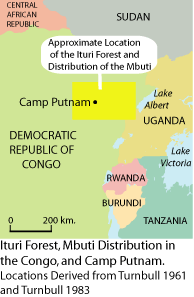In 1946 Anne Eisner, a promising New York painter, married Patrick Putnam and followed him to the Ituri forest of the Belgian Congo to live with his African wives. An amateur anthropologist seven years older than she was, Putnam soon became physically and mentally ill, so Eisner cared for him while he degenerated and finally died in 1953. During her first period of living at Camp Putnam, 1946 to 1954, Eisner painted village scenes, collected two hundred folk tales from the Mbuti, and helped raise three orphaned children.
 Christie McDonald, Eisner’s niece, describes in a recent journal article her aunt’s life at Camp Putnam, the settlement in the Ituri Forest of both Mbuti Pygmies and Bira agricultural villagers that Putnam had established in the 1930s. Along with her remarkable ability to get along with colonial administrators, Eisner was able to live effectively with the Bira and the Mbuti, a white woman at the intersection of numerous worlds that were beginning to change as the end of the colonial period neared. She stayed at Camp Putnam for a year after her husband died, left in 1954, but came back for another year, from 1957 to 1958, when she returned to the United States for good.
Christie McDonald, Eisner’s niece, describes in a recent journal article her aunt’s life at Camp Putnam, the settlement in the Ituri Forest of both Mbuti Pygmies and Bira agricultural villagers that Putnam had established in the 1930s. Along with her remarkable ability to get along with colonial administrators, Eisner was able to live effectively with the Bira and the Mbuti, a white woman at the intersection of numerous worlds that were beginning to change as the end of the colonial period neared. She stayed at Camp Putnam for a year after her husband died, left in 1954, but came back for another year, from 1957 to 1958, when she returned to the United States for good.
She shared the Mbuti folk tales she had collected with the young anthropologist Colin Turnbull, who used them, with her permission, in his own publications. Unfortunately, Turnbull interpreted them differently than Eisner did, and his view of the Mbuti Pygmies became world famous when his book The Forest People came out. His interpretation of Mbuti relations with the nearby Bira agricultural villagers reflected his worldview more than it did the reality of the complex relationships between the Mbuti and the other local African people.
The major argument of McDonald’s article is that Turnbull developed an oppositional worldview in which he idealized the Mbuti as basically virtuous and peaceful, in contrast to other peoples such as the Bira that are not. This viewpoint comes out clearly in The Forest People, where the reader is left with the overwhelming feeling that the peaceful Mbuti would have been better off to avoid the nearby agricultural villages. The idealized peacefulness and beauty are always in the forest, not out in the glare, heat, and conflict of the open village.
Turnbull’s analysis of the Mbuti folktales was first published in 1959 in the article “Legends of the BaMbuti,” Journal of the Royal Anthropological Institute of Great Britain and Ireland, Volume 89 (1). His treatment of the Mbuti folk tales in that article reflects, to some extent, his binary view of forest versus village, virtue versus vice, sacred versus profane.
One of the tales, for instance, tells the story of a devil that comes into a home and kills a child, but it changes, in Turnbull’s article, into a story of a bad mother who allows a Satan figure to kill her child. The theme of the story thus became oppositional, a good mother versus a bad mother, an addition that didn’t exist in the tale gathered by Eisner. McDonald does consider the possibility that Eisner, in fact, may have collaborated with Turnbull in that revision, possibly to reflect her own conflicted feelings of being a bad adoptive mother for having left Camp Putnam in 1954 to return to the United States. The Eisner and Turnbull records do not make the issue clear.
McDonald analyzes some of Eisner’s paintings of Mbuti and Bira women and concludes that Eisner had a very different view of Mbuti relationships with the nearby villages from Turnbull’s. She perceived, for instance, that the Mbuti women could more easily move among the village women than the Mbuti men could fit in with the village men. The Pygmy women could marry the village men, but the Bira women would never marry Mbuti men. Even more important to McDonald is the fact that Eisner herself could cross the divides separating the Mbuti and the Bira, the forest and the village. Eisner didn’t see their relationships as opposites, and her paintings portray the cooperation that often existed between the village women and the Pygmy women.
Unlike Turnbull, McDonald concludes, Eisner was interested in the multicultural society she saw at Camp Putnam, and she herself, as a white American woman and adoptive mother of three Mbuti Pygmy children, was certainly part of that multicultural experience.
McDonald, Christie. 2004. “Ethnography, Literature, and Art in the Work of Anne Eisner (Putnam): Making Sense of Colonial Life in the Ituri Forest.” Research in African Literatures 35(4): 1 – 16.